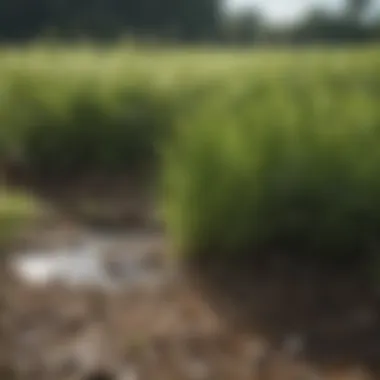Understanding the Adequate Watering Practices for Grass Seed Growth


Gardening Guide
When it comes to nurturing grass seed, watering plays a crucial role in ensuring a successful outcome. Understanding the watering needs of grass seed is pivotal for fostering healthy growth and establishing a lush lawn. Proper watering practices are essential for homeowners and gardening enthusiasts alike, as they contribute significantly to the overall health and vitality of the grass.
Key Points to Consider
Watering grass seed is essential for optimal growth and establishment. It is crucial to strike a balance, ensuring the seeds remain consistently moist without being waterlogged. Overwatering can lead to fungus and disease, while underwatering may result in stunted growth and patchy areas in the lawn.
Importance of Watering Grass Seed
Watering is vital for the germination process, as seeds require moisture to sprout and develop. Consistent and adequate watering promotes deep root growth, resilience to environmental stress, and overall turf health. By understanding the watering needs of grass seed, individuals can enhance the chances of a successful lawn establishment.
Best Practices for Watering
To achieve optimal results, it is advisable to water grass seed in the early morning or late evening to minimize evaporation and ensure maximum absorption. Use a sprinkler or hose with a gentle spray to water evenly, avoiding puddling or runoff. Monitoring the soil moisture levels through touch or specialized tools helps to adjust the watering frequency accordingly.
Common Mistakes to Avoid
One common mistake is irregular watering, which can lead to uneven germination and patchy grass growth. Additionally, excessive watering or infrequent deep watering can inhibit deep root development, making the grass more susceptible to drought and stress. It is important to follow a consistent watering schedule and observe the lawn's response to adjustments.
By following these guidelines and understanding the intricate balance required for watering grass seed, individuals can nurture healthy growth and establish a vibrant green lawn to enjoy.
Introduction
Watering grass seed is a pivotal aspect in ensuring the optimal growth and establishment of a new lawn. Adequate watering plays a crucial role in the germination of seeds, promoting healthy grass growth, and maintaining overall lawn vitality. This comprehensive guide delves deep into the importance of proper watering practices, shedding light on key considerations essential for homeowners and gardening enthusiasts alike. By understanding the significance of watering grass seed, individuals can pave the way for a lush, green landscape that thrives in various environmental conditions.
Understanding the Importance of Watering Grass Seed
Role of Water in Seed Germination
The role of water in seed germination is fundamental to the success of establishing a healthy lawn. Water acts as a catalyst that triggers the germination process, enabling seeds to absorb essential nutrients and moisture for growth. This process is crucial for jumpstarting the life cycle of grass seeds, leading to robust root development and subsequent plant emergence. Understanding the intricate relationship between water and seed germination is paramount for achieving optimal grass growth and ensuring a verdant landscape.
Impact of Watering on Grass Growth
Watering directly influences the growth and development of grass post-germination. Consistent watering regimes promote root establishment, leaf expansion, and overall plant vigor. Insufficient watering can hinder grass growth, leading to stunted plants and sparse coverage. Conversely, overwatering may result in waterlogged soil conditions, suffocating roots and promoting fungal diseases. Striking a balance in watering is crucial to fostering healthy grass growth and maintaining a vibrant lawn ecosystem.


Factors Influencing Watering Needs
Various factors come into play when determining the watering requirements of grass seed. Climate, soil type, grass species, and environmental conditions all impact the amount and frequency of watering necessary for optimal growth. Understanding the specific needs of the grass species being cultivated and adjusting watering practices accordingly is key to sustaining lush, resilient turf. By recognizing and adapting to these influencing factors, individuals can tailor their watering routines to ensure the long-term health and vitality of their lawn.
Common Questions About Watering Grass Seed
How Often Should You Water Newly Seeded Lawn?
The frequency of watering a newly seeded lawn is a critical consideration for successful establishment. Newly seeded lawns require consistent moisture to support germination and early growth stages. Optimal watering frequency may vary depending on soil conditions, weather patterns, and grass species. Overlooking the importance of regular watering can impede seed germination and lead to patchy lawn growth. By adhering to a well-defined watering schedule, homeowners can nurture new grass growth and foster a lush lawn landscape.
Is It Possible to Overwater Grass Seed?
Overwatering grass seed is indeed a common pitfall that can have detrimental effects on lawn health. Excessive moisture levels in soil can suffocate roots, inhibit nutrient uptake, and promote fungal diseases. Signs of overwatering include waterlogged soil, yellowing grass blades, and a lack of oxygen in the root zone. Understanding the risks associated with overwatering and adjusting watering practices accordingly is essential to prevent damage and maintain a thriving lawn.
What Is the Best Time of Day to Water Grass Seed?
Selecting the optimal time of day for watering grass seed is crucial for maximizing water absorption and minimizing moisture loss. Early morning or late evening are generally recommended times to water grass seed, as cooler temperatures reduce evaporation rates and allow water to penetrate deeply into the soil. Watering during midday may lead to excessive evaporation and potential stress on grass plants. By aligning watering schedules with favorable weather conditions, individuals can optimize water usage efficiency and promote healthy grass growth.
Watering Guidelines for Grass Seed
Watering Guidelines for Grass Seed play a crucial role in ensuring the successful growth and establishment of your grass seed. By following specific watering techniques and routines, you can create optimal conditions for seed germination and healthy grass development. Understanding the importance of watering guidelines is essential for homeowners and gardening enthusiasts looking to achieve lush, verdant lawns. Proper watering practices not only promote plant growth but also help in the prevention of common issues such as under or overwatering.
Establishing a Watering Routine
Establishing a Watering Routine is the foundation of adequate lawn care management. One key aspect is the initial watering after seeding. This initial watering is critical as it kickstarts the germination process and provides essential moisture for the seeds to sprout. By ensuring the soil is adequately moist but not waterlogged, you set the stage for healthy grass growth. Subsequent watering schedules should maintain this balance, nurturing the young plants without drowning them in excess water. Additionally, adjusting watering frequency based on weather conditions is vital to prevent issues like drought stress or fungal growth.
Proper Watering Techniques
Proper Watering Techniques are essential for promoting even growth and preventing water-related damage. Even distribution of water ensures that all areas of the lawn receive adequate moisture, promoting uniform growth. Avoiding pooling or runoff helps prevent water wastage and the uneven saturation of soil, which can lead to root rot. Using irrigation systems effectively can simplify the watering process, allowing for targeted and efficient watering. By understanding and implementing these techniques, you ensure that your grass seed receives the necessary hydration for healthy development.
Signs of Underwatering and Overwatering
Recognizing Signs of Underwatering and Overwatering is crucial for adjusting your watering practices accordingly. Yellowing or wilting grass indicates a lack of moisture, signaling the need for increased watering. Conversely, waterlogged soil presents issues such as poor root oxygenation and nutrient uptake, necessitating adjustments to drainage and watering frequency. Preventing fungal growth requires maintaining proper moisture levels to inhibit fungal spores' germination and proliferation. By identifying and addressing these signs promptly, you can promote the optimal health and growth of your grass seed.
Best Practices and Tips:


When delving into the realm of grass seed watering, understanding the significance of best practices and tips is paramount. These guidelines serve as pillars for nurturing your lawn from seedling to lush maturity. Optimizing water absorption tops the list of crucial practices. By aerating soil for improved water penetration, you facilitate the entry of water deep into the earth, reaching the roots for enhanced growth. This technique promotes soil health and encourages robust grass development. Mulching is another fundamental tactic that aids in retaining moisture, ensuring a well-hydrated environment for seed germination and growth. It acts as a natural shield against evaporation, fostering a conducive setting for your grass to thrive. Lastly, avoiding heavy foot traffic on newly seeded areas is key. Excessive pressure can compact the soil, hindering water infiltration and root expansion. Implementing these best practices proactively sets the stage for a flourishing lawn.
Optimizing Water Absorption:
Aerating soil for improved water penetration:
In the context of grass seed watering, aerating soil plays a pivotal role in facilitating water absorption. This method involves creating channels in the soil, allowing moisture to permeate effectively and reach the underlying roots. Aeration enhances soil structure, promoting root growth and nutrient uptake. Its distinguishing feature lies in its ability to mitigate compaction issues, ensuring optimal water circulation within the soil. By incorporating aeration into your lawn care routine, you foster a thriving ecosystem for your grass to flourish.
Mulching to retain moisture:
Within the spectrum of watering practices, mulching emerges as a vital tool for maintaining soil moisture levels. This technique involves placing a layer of organic material over the soil surface, acting as a barrier against evaporation. Mulch preserves soil hydration, reducing water loss to the atmosphere and creating a stable microclimate for seed germination. Its unique characteristic lies in its dual functionality of moisture retention and weed suppression. Implementing mulching strategies empowers homeowners to conserve water effectively while nurturing their grass to maturity.
Avoiding heavy foot traffic on newly seeded areas:
Effective grass seed establishment hinges on preventing unnecessary stress on newly seeded areas, primarily by avoiding heavy foot traffic. Compaction from frequent walking or machinery use can impede water absorption and root development, compromising the overall health of the grass. This practice is instrumental in maintaining soil aeration and promoting unhindered root growth. The distinct advantage of this approach is the preservation of soil integrity and moisture balance, ensuring optimal conditions for seedling growth and subsequent turf vitality.
Dealing with Drought Conditions:
Drought-resistant grass species:
In the realm of water conservation and lawn maintenance, selecting drought-resistant grass species proves instrumental for enduring dry spells. These variants possess genetic traits that enable them to thrive in arid conditions, requiring minimal water input for sustenance. Their key characteristic lies in their innate ability to withstand prolonged drought periods without compromising aesthetics or health. Opting for drought-resistant species is a strategic choice for homeowners seeking to conserve water resources while maintaining a green and resilient lawn.
Water conservation strategies:
Embracing water conservation strategies is paramount for sustainable lawn management, especially during water scarcity. These methodologies encompass practices like rainwater harvesting, drip irrigation, and xeriscaping, aimed at reducing water waste and optimizing usage efficiency. The primary perk of these strategies is their ability to lessen water consumption without compromising lawn health or visual appeal. By integrating water-efficient techniques into your lawn care regimen, you contribute to environmental conservation while nurturing a vibrant and lush landscape.
Reviving grass in dry spells:
Reviving dormant grass during dry spells necessitates a strategic approach to restoring vitality and color to your lawn. Employing practices such as deep watering, overseeding, and targeted fertilization can revitalize parched grass, inducing new growth and rejuvenation. The unique feature of this revitalization process lies in its ability to kickstart the grass's metabolic functions, invigorating it from dormancy to active growth. By administering these revival techniques judiciously, homeowners can revive their lawn post-drought, fostering a verdant, resilient turf surface.
Mistakes to Avoid
In this section, we will delve into the crucial topic of Mistakes to Avoid when watering grass seed. Understanding and avoiding common errors can significantly impact the growth and establishment of your grass. By recognizing and rectifying these mistakes, homeowners and gardening enthusiasts can ensure a healthy and thriving lawn. Proper watering techniques are essential for successful grass seed germination and growth, making it imperative to address and overcome potential pitfalls.
Common Watering Errors


Overlooking daily monitoring of soil moisture
The oversight of daily monitoring of soil moisture is a prevalent mistake that can hinder the growth of grass seed. Failure to consistently assess the soil's moisture levels can lead to underwatering or overwatering, both of which are detrimental to grass development. By neglecting to monitor soil moisture daily, individuals risk compromising the germination process and impeding the establishment of a lush lawn.
Failing to adjust watering based on weather
Failing to adjust watering practices according to the weather conditions poses a significant challenge to grass seed growth. Different weather patterns demand varying levels of watering to cater to the evolving needs of the grass. Ignoring these fluctuations can result in overwatering during rainy periods or underwatering in dry spells, impacting the grass's health and vitality.
Using high-pressure watering methods
The utilization of high-pressure watering methods can be counterproductive to grass seed growth. While it may seem efficient, excessive water pressure can compact the soil, disrupt seed placement, and lead to uneven watering. This approach may also cause soil erosion and damage delicate seeds, impeding germination and overall lawn development.
Effects of Improper Watering
Stunted growth and weak root development
Stunted growth and weak root development are direct consequences of improper watering techniques. When grass seeds do not receive adequate water or are subjected to inconsistent watering, they struggle to establish strong roots and grow optimally. This results in a patchy and sparse lawn, impeding the overall health and appearance of the grass.
Increased susceptibility to diseases
Improper watering practices heighten the grass's susceptibility to diseases and infections. Overwatering can create a breeding ground for fungal and bacterial pathogens, causing diseases that weaken the grass and hinder its growth. Neglecting proper watering techniques compromises the grass's natural defenses, making it prone to various illnesses.
Patchy or uneven grass coverage
Patchy or uneven grass coverage is a visible outcome of improper watering methods. When certain areas of the lawn receive excess water while others remain dry, the grass growth becomes uneven and patchy. This not only affects the aesthetic appeal of the lawn but also indicates underlying issues in moisture distribution, requiring immediate corrective measures to foster uniform grass growth.
Conclusion
The conclusion of this comprehensive guide on watering grass seed is paramount to the success of establishing a healthy lawn. By following the outlined watering guidelines and best practices, homeowners and gardening enthusiasts can ensure optimal growth and vitality of their grass seed. The importance of proper watering techniques cannot be overstated, as they directly impact seed germination, grass growth, and long-term maintenance.
Ensuring Successful Grass Seed Establishment
Summary of Key Watering Practices
The summary of key watering practices serves as a foundational aspect of this article, providing essential guidance for individuals looking to promote successful grass seed establishment. Detailing the frequency of watering, ideal watering techniques, and signs of under or overwatering, this section equips readers with the knowledge needed to nurture their grass seed effectively. By emphasizing the significance of consistent and adequate water supply, the summary of key watering practices contributes significantly to achieving a lush and healthy lawn. Its detailed insights into optimizing water absorption, preventing drought stress, and recognizing watering errors make it an invaluable resource for readers seeking to enhance their understanding of proper lawn care.
Long-term Maintenance for Healthy Lawn
A crucial component of successful grass seed establishment is long-term maintenance for a healthy lawn. This section focuses on the post-germination care required to sustain the lushness and vibrancy of newly grown grass. By discussing ongoing watering routines, mowing practices, and pest management strategies, readers gain a comprehensive understanding of the continuous efforts needed to preserve a thriving lawn. The emphasis on aerating soil, mulching for moisture retention, and implementing water conservation techniques underscores the commitment necessary for maintaining a green and resilient turf over time.
Appreciating the Impact of Proper Watering
Appreciating the impact of proper watering goes beyond the immediate growth phase to acknowledge the long-lasting benefits of diligent lawn care practices. This aspect highlights the profound influence that adequate water supply has on the overall health and appearance of grass. By recognizing the connection between watering habits and the resilience of grass seed to environmental stressors, readers can cultivate an appreciation for the transformative power of proper irrigation. Understanding how effective watering can contribute to disease prevention, root development, and sustainable lawn growth encourages individuals to invest in conscientious watering practices that yield enduring results.







